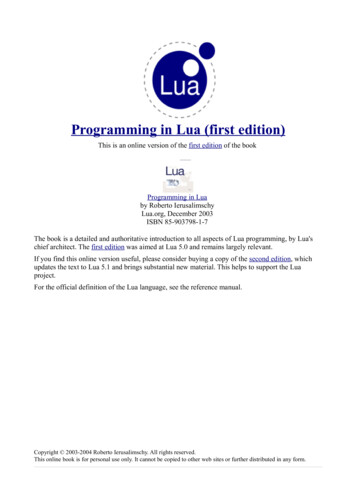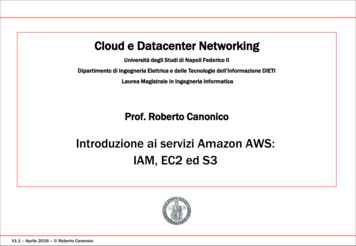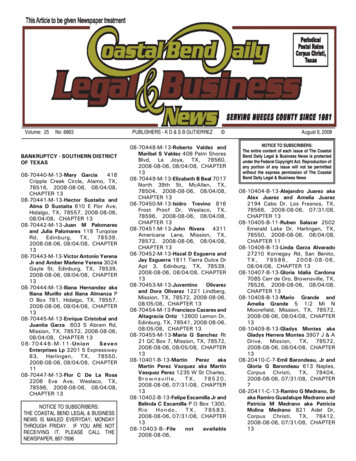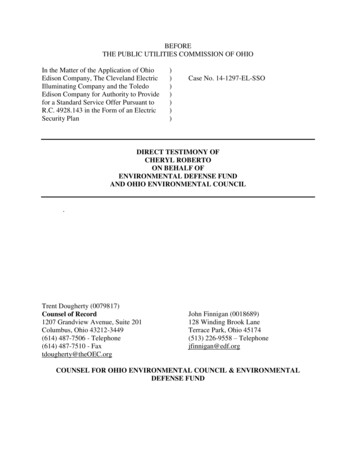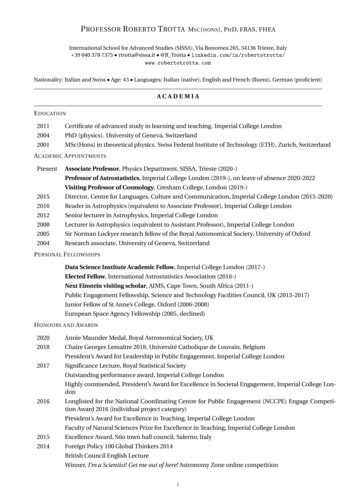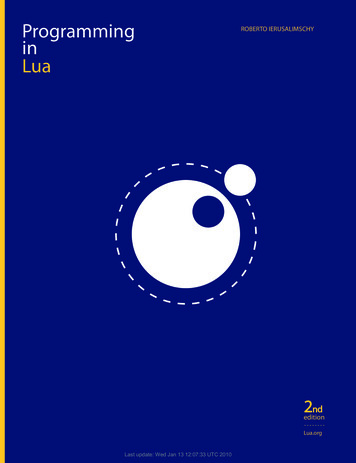
Transcription
ProgramminginLuaROBERTO IERUSALIMSCHY2ndeditionLua.orgLast update: Wed Jan 13 12:07:33 UTC 2010
Programming in LuaProperty of Ian Bloss ianlinkcd@gmail.com
Property of Ian Bloss ianlinkcd@gmail.com
Programming in LuaSecond EditionRoberto IerusalimschyPUC-Rio, BrazilLua.orgRio de JaneiroProperty of Ian Bloss ianlinkcd@gmail.com
Programming in Lua, Second Editionby Roberto IerusalimschyISBN 85-903798-2-5Copyright c 2006, 2003 by Roberto Ierusalimschy. All rights reserved.The author can be contacted at roberto@lua.org.Book cover and illustrations by Dimaquina. Lua logo design by Alexandre Nako.Typesetting by the author using LATEX.Although the author used his best efforts preparing this book, he assumes noresponsibility for errors or omissions, or for any damage that may result fromthe use of the information presented here. All product names mentioned in thisbook are trademarks of their respective owners.CIP – Biblioteca do Departamento de Informática, PUC-RioI22Ierusalimschy, RobertoProgramming in Lua / Roberto Ierusalimschy. – 2nd ed.– Rio de Janeiro, 2006.xviii, 308 p. : 25 cm.Includes index.ISBN 85-903798-2-51. Lua (Programming language).I. Title.005.133 – dc20Property of Ian Bloss ianlinkcd@gmail.com
to Ida, Noemi, and Ana LuciaProperty of Ian Bloss ianlinkcd@gmail.com
Property of Ian Bloss ianlinkcd@gmail.com
ContentsPrefacexiiiIThe Language1Getting Started 31.1 Chunks 41.2 Some Lexical Conventions 51.3 Global Variables 61.4 The Stand-Alone Interpreter 72Types and Values 92.1 Nil 102.2 Booleans 102.3 Numbers 102.4 Strings 112.5 Tables 132.6 Functions 172.7 Userdata and Threads3117Expressions 193.1 Arithmetic Operators 193.2 Relational Operators 203.3 Logical Operators 213.4 Concatenation 223.5 Precedence 223.6 Table Constructors 22viiProperty of Ian Bloss ianlinkcd@gmail.com
viiiContents45Statements 274.1 Assignment 274.2 Local Variables and Blocks4.3 Control Structures 304.4 break and return 3428Functions 355.1 Multiple Results 365.2 Variable Number of Arguments5.3 Named Arguments 426More About Functions 456.1 Closures 476.2 Non-Global Functions 506.3 Proper Tail Calls 527Iterators and the Generic for 557.1 Iterators and Closures 557.2 The Semantics of the Generic for7.3 Stateless Iterators 587.4 Iterators with Complex State 607.5 True Iterators 6139578Compilation, Execution, and Errors 638.1 Compilation 638.2 C Code 678.3 Errors 678.4 Error Handling and Exceptions 698.5 Error Messages and Tracebacks 709Coroutines 739.1 Coroutine Basics 739.2 Pipes and Filters 769.3 Coroutines as Iterators 799.4 Non-Preemptive Multithreading10Complete Examples 8710.1 Data Description 8710.2 Markov Chain AlgorithmIITables and Objects11Data Structures11.1 Arrays 9781919597Property of Ian Bloss ianlinkcd@gmail.com
ix11.211.311.411.511.611.7Matrices and Multi-Dimensional ArraysLinked Lists 100Queues and Double Queues 100Sets and Bags 101String Buffers 103Graphs 10412Data Files and Persistence12.1 Data Files 10712.2 Serialization 10913Metatables and Metamethods 11713.1 Arithmetic Metamethods 11813.2 Relational Metamethods 12013.3 Library-Defined Metamethods 12213.4 Table-Access Metamethods 12214The Environment 12914.1 Global Variables with Dynamic Names14.2 Global-Variable Declarations 13114.3 Non-Global Environments 1321598107129Modules and Packages 13715.1 The require Function 13815.2 The Basic Approach for Writing Modules15.3 Using Environments 14315.4 The module Function 14415.5 Submodules and Packages 14516Object-Oriented Programming 14916.1 Classes 15116.2 Inheritance 15216.3 Multiple Inheritance 15416.4 Privacy 15616.5 The Single-Method Approach 15817Weak Tables 16117.1 Memoize Functions 16317.2 Object Attributes 16417.3 Revisiting Tables with Default ValuesIIIThe Standard Libraries18The Mathematical Library165167169Property of Ian Bloss ianlinkcd@gmail.com 141
xContents19The Table Library 17119.1 Insert and Remove 17119.2 Sort 17219.3 Concatenation 17320The String Library 17520.1 Basic String Functions 17520.2 Pattern-Matching Functions 17720.3 Patterns 18020.4 Captures 18320.5 Replacements 18520.6 Tricks of the Trade 18921The I/O Library 19321.1 The Simple I/O Model 19321.2 The Complete I/O Model 19621.3 Other Operations on Files 19922The Operating System Library22.1 Date and Time 20122.2 Other System Calls 20323The Debug Library 20523.1 Introspective Facilities23.2 Hooks 21023.3 Profiles 211IV The C API24201205215An Overview of the C API 21724.1 A First Example 21824.2 The Stack 22124.3 Error Handling with the C API25Extending Your Application 22925.1 The Basics 22925.2 Table Manipulation 23125.3 Calling Lua Functions 23525.4 A Generic Call Function 23626Calling C from Lua 24126.1 C Functions 24126.2 C Modules 244225Property of Ian Bloss ianlinkcd@gmail.com
xi27Techniques for Writing C Functions 24727.1 Array Manipulation 24727.2 String Manipulation 24927.3 Storing State in C Functions 25128User-Defined Types in C 25928.1 Userdata 26028.2 Metatables 26228.3 Object-Oriented Access 26528.4 Array Access 26728.5 Light Userdata 26829Managing Resources 26929.1 A Directory Iterator 26929.2 An XML Parser 27130Threads and States 28130.1 Multiple Threads 28130.2 Lua States 28531Memory Management 29331.1 The Allocation Function 29331.2 The Garbage Collector 295Index299Property of Ian Bloss ianlinkcd@gmail.com
Property of Ian Bloss ianlinkcd@gmail.com
PrefaceWhen Waldemar, Luiz, and I started the development of Lua, back in 1993, wecould hardly imagine that it would spread as it did. Started as an in-houselanguage for two specific projects, currently Lua is widely used in all areas thatcan benefit from a simple, extensible, portable, and efficient scripting language,such as embedded systems, mobile devices, web servers, and, of course, games.We designed Lua, from the beginning, to be integrated with software writtenin C and other conventional languages. This integration brings many benefits.Lua is a tiny and simple language, partly because it does not try to do what C isalready good for, such as sheer performance, low-level operations, and interfacewith third-party software. Lua relies on C for these tasks. What Lua doesoffer is what C is not good for: a good distance from the hardware, dynamicstructures, no redundancies, ease of testing and debugging. For this, Lua hasa safe environment, automatic memory management, and good facilities forhandling strings and other kinds of data with dynamic size.A great part of the power of Lua comes from its libraries. This is not bychance. After all, one of the main strengths of Lua is its extensibility. Many features contribute to this strength. Dynamic typing allows a great degree of polymorphism. Automatic memory management simplifies interfaces, because thereis no need to decide who is responsible for allocating and deallocating memory,or how to handle overflows. Higher-order functions and anonymous functionsallow a high degree of parameterization, making functions more versatile.More than an extensible language, Lua is also a glue language. Lua supports a component-based approach to software development, where we createan application by gluing together existing high-level components. These components are written in a compiled, statically typed language, such as C or C ;Lua is the glue that we use to compose and connect these components. Usually,the components (or objects) represent more concrete, low-level concepts (such aswidgets and data structures) that are not subject to many changes during program development, and that take the bulk of the CPU time of the final program.Lua gives the final shape of the application, which will probably change a lotduring the life cycle of the product. However, unlike other glue technologies,Lua is a full-fledged language as well. Therefore, we can use Lua not only toxiiiProperty of Ian Bloss ianlinkcd@gmail.com
xivPrefaceglue components, but also to adapt and reshape them, and to create whole newcomponents.Of course, Lua is not the only scripting language around. There are otherlanguages that you can use for more or less the same purposes. But Lua offersa set of features that makes it your best choice for many tasks and gives it aunique profile:Extensibility: Lua’s extensibility is so remarkable that many people regard Luanot as a language, but as a kit for building domain-specific languages. Luahas been designed from scratch to be extended, both through Lua code andthrough external C code. As a proof of concept, Lua implements most ofits own basic functionality through external libraries. It is really easy tointerface Lua with C/C , and Lua has been used integrated with severalother languages as well, such as Fortran, Java, Smalltalk, Ada, C#, andeven with other scripting languages, such as Perl and Ruby.Simplicity: Lua is a simple and small language. It has few (but powerful)concepts. This simplicity makes Lua easy to learn and contributes to itssmall size. Its complete distribution (source code, manual, plus binariesfor some platforms) fits comfortably in a floppy disk.Efficiency: Lua has a quite efficient implementation. Independent benchmarksshow Lua as one of the fastest languages in the realm of scripting (interpreted) languages.Portability: When we talk about portability, we are not talking about runningLua both on Windows and on Unix platforms. We are talking about running Lua on all platforms we have ever heard about: PlayStation, XBox,Mac OS-9 and OS X, BeOS, QUALCOMM Brew, MS-DOS, IBM mainframes, RISC OS, Symbian OS, PalmOS, ARM processors, Rabbit processors, plus of course all flavors of Unix and Windows. The source code foreach of these platforms is virtually the same. Lua does not use conditionalcompilation to adapt its code to different machines; instead, it sticks tothe standard ANSI (ISO) C. This way, you do not usually need to adapt itto a new environment: if you have an ANSI C compiler, you just have tocompile Lua, out of the box.AudienceLua users typically fall into three broad groups: those that use Lua alreadyembedded in an application program, those that use Lua stand alone, and thosethat use Lua and C together.Many people use Lua embedded in an application program, such as CGILua(for building dynamic Web pages) or a game. These applications use the Lua–C API to register new functions, to create new types, and to change the behaviorof some language operations, configuring Lua for their specific domains. Frequently, the users of such applications do not even know that Lua is an independent language adapted for a particular domain; for instance, CGILua usersProperty of Ian Bloss ianlinkcd@gmail.com
xvtend to think of Lua as a language specifically designed for the Web; players ofa specific game may regard Lua as a language exclusive to that game.Lua is useful also as a stand-alone language, not only for text-processingand one-shot little programs, but increasingly for medium-to-large projects, too.For such uses, the main functionality of Lua comes from libraries. The standard libraries offer pattern matching and other functions for string handling.(We may regard the stand-alone language as the embedding of Lua into thedomain of string and text-file manipulation.) As Lua improves its support for libraries, there has been a proliferation of external packages. The Kepler project(http://www.keplerproject.org), for instance, is a Web development platformfor Lua that offers packages for page generation, database access, LDAP, XML,and SOAP. The LuaForge site (http://www.luaforge.net) offers a focal pointfor many Lua packages.Finally, there are those programmers that work on the other side of thebench, writing applications that use Lua as a C library. Those people willprogram more in C than in Lua, although they need a good understanding ofLua to create interfaces that are simple, easy to use, and well integrated withthe language.This book has much to offer to all these people. The first part covers thelanguage itself, showing how we can explore all its potential. We focus ondifferent language constructs and use numerous examples to show how to usethem for practical tasks. Some chapters in this part cover basic concepts, suchas control structures, but there are also advanced topics, such as iterators andcoroutines.The second part is entirely devoted to tables, the sole data structure in Lua.Its chapters discuss data structures, persistence, packages, and object-orientedprogramming. There we will unveil the real power of the language.The third part presents the standard libraries. This part is particularlyuseful for those that use Lua as a stand-alone language, although many otherapplications also incorporate all or part of the standard libraries. This partdevotes one chapter to each standard library: the mathematical library, the tablelibrary, the string library, the I/O library, the operating system library, and thedebug library.Finally, the last part of the book covers the API between Lua and C, for thosethat use C to get the full power of Lua. This part necessarily has a flavor quitedifferent from the rest of the book. There we will be programming in C, notin Lua; therefore, we will be wearing a different hat. For some readers, thediscussion of the C API may be of marginal interest; for others, it may be themost relevant part of this book.About the Second EditionThis book is an updated and expanded version of the first edition of Programming in Lua (also known as the PiL book). Although the book structure is virtually the same, this new edition has substantial new material.Property of Ian Bloss ianlinkcd@gmail.com
xviPrefaceFirst, I have updated the whole book to Lua 5.1. Of particular relevance isthe chapter about modules and packages, which was mostly rewritten. I alsorewrote several examples to show how to benefit from the new features offeredby Lua 5.1. Nevertheless, I clearly marked features absent from Lua 5.0, so youcan use the book for that version too.Second, there are several new examples. These examples cover graph representation, tab expansion and compression, an implementation for tuples, andmore.Third, there are two complete new chapters. One is about how to use multiplestates and multiple threads from C; it includes a nice example of how to implement a multi-process facility for Lua. The other is about memory managementand how to interact with memory allocation and garbage collection.After the release of the first edition of Programming in Lua, several publishers contacted us showing interest in a second edition. In the end, however, wedecided to self publish this second edition, as we did with the first one. Despitethe limited marketing, this avenue brings several benefits: we have total control over the book contents, we have freedom to choose when to release anotheredition, we can ensure that the book does not go out of print, and we keep thefull rights to offer the book in other forms.Other ResourcesThe reference manual is a must for anyone who wants to really learn a language.This book does not replace the Lua reference manual. Quite the opposite, theycomplement each other. The manual only describes Lua. It shows neitherexamples nor a rationale for the constructs of the language. On the other hand,it describes the whole language; this book skips over seldom-used dark corners ofLua. Moreover, the manual is the authoritative document about Lua. Whereverthis book disagrees with the manual, trust the manual. To get the manual andmore information about Lua, visit the Lua site at http://www.lua.org.You can also find useful information at the Lua users site, kept by thecommunity of users at http://lua-users.org. Among other resources, it offersa tutorial, a list of third-party packages and documentation, and an archive ofthe official Lua mailing list. You should check also the book’s web page:http://www.inf.puc-rio.br/ roberto/pil2/There you can find updated errata, code for some of the examples presented inthe book, and some extra material.This book describes Lua 5.1, although most of its contents also apply toLua 5.0. The few differences between Lua 5.1 and Lua 5.0 are clearly marked inthe text. If you are using a more recent version, check the corresponding manualfor occasional differences between versions. If you are using a version older than5.0, this is a good time to upgrade.Property of Ian Bloss ianlinkcd@gmail.com
xviiA Few Typographical ConventionsThe book encloses “literal strings” between double quotes and single characters, like ‘a’, between single quotes. Strings that are used as patterns are alsoenclosed between single quotes, like ‘[%w ]*’. The book uses a typewriter fontboth for little chunks of code and for identifiers. Larger chunks of code areshown in display style:-- program "Hello World"print("Hello World")-- Hello WorldThe notation -- shows the output of a statement or, occasionally, the result ofan expression:print(10)13 3-- 10-- 16Because a double hyphen (--) starts a comment in Lua, there is no problemif you include these annotations in your programs. Finally, the book uses thenotation -- to indicate that something is equivalent to something else:this -- thatThat is, it makes no difference to Lua whether you write this or that.AcknowledgmentsThis book would be impossible without the help of several friends and institutions. As always, Luiz Henrique de Figueiredo and Waldemar Celes, Lua codevelopers, offered all kinds of help.Gavin Wraith, André Carregal, Asko Kauppi, Brett Kapilik, John D. Ramsdell, and Edwin Moragas reviewed drafts of this book and provided invaluablesuggestions.Lightning Source, Inc. proved a reliable and efficient option for printing anddistributing the book. Without them, the option of self-publishing the bookwould probably not be an option.Antonio Pedro, from Dimaquina, patiently endured my shifting opinions andproduced the right cover design.Norman Ramsey kindly provided useful insights about the best way to publish this book.I also would like to thank PUC-Rio and CNPq for their continuous supportto my work.Finally, I must express my deep gratitude to Noemi Rodriguez, for illuminingmy life.Property of Ian Bloss ianlinkcd@gmail.com
Property of Ian Bloss ianlinkcd@gmail.com
Part IThe LanguageProperty of Ian Bloss ianlinkcd@gmail.com
Property of Ian Bloss ianlinkcd@gmail.com
1Getting StartedTo keep with the tradition, our first program in Lua just prints “Hello World”:print("Hello World")If you are using the stand-alone Lua interpreter, all you have to do to run yourfirst program is to call the interpreter — usually named lua — with the name ofthe text file that contains your program. If you write the above program in a filehello.lua, the following command should run it:% lua hello.luaAs a more complex example, the next program defines a function to computethe factorial of a given number, then asks the user for a number and prints itsfactorial:-- defines a factorial functionfunction fact (n)if n 0 thenreturn 1elsereturn n * fact(n-1)endendprint("enter a number:")a io.read("*number")print(fact(a))-- read a number3Property of Ian Bloss ianlinkcd@gmail.com
4Chapter 1Getting StartedIf you are using Lua embedded in an application, such as CGILua or IUPLua,you may need to refer to the application manual (or to a “local guru”) to learnhow to run your programs. Nevertheless, Lua is still the same language; mostthings that we will see here are valid regardless of how you are using Lua. I recommend that you start your study of Lua by using the stand-alone interpreter(lua) to run your first examples and experiments.1.1 ChunksEach piece of code that Lua executes, such as a file or a single line in interactive mode, is called a chunk. A chunk is simply a sequence of commands (orstatements).Lua needs no separator between consecutive statements, but you can usea semicolon if you wish. My personal convention is to use semicolons only toseparate two or more statements written in the same line. Line breaks play norole in Lua’s syntax; for instance, the following four chunks are all valid andequivalent:a 1b a*2a 1;b a*2;a 1; b a*2a 1b a*2-- ugly, but validA chunk may be as simple as a single statement, such as in the “Hello World”example, or it may be composed of a mix of statements and function definitions(which are actually assignments, as we will see later), such as the factorialexample. A chunk may be as large as you wish. Because Lua is used also as adata-description language, chunks with several megabytes are not uncommon.The Lua interpreter has no problems at all with large chunks.Instead of writing your program to a file, you may run the stand-aloneinterpreter in interactive mode. If you call lua without any arguments, youwill get its prompt:Lua 5.1 Copyright (C) 1994-2006 Lua.org, PUC-RioThereafter, each command that you type (such as print "Hello World") executesimmediately after you enter it. To exit the interactive mode and the interpreter, just type the end-of-file control character (ctrl-D in Unix, ctrl-Z inDOS/Windows), or call the exit function, from the Operating System library —you have to type os.exit().In interactive mode, Lua usually interprets each line that you type as acomplete chunk. However, if it detects that the line does not form a completeProperty of Ian Bloss ianlinkcd@gmail.com
1.2Some Lexical Conventions5chunk, it waits for more input, until it has a complete chunk. This way youcan enter a multi-line definition, such as the factorial function, directly ininteractive mode. However, it is usually more convenient to put such definitionsin a file, and then call Lua to run this file.You may use the -i option to instruct Lua to start an interactive session afterrunning the given chunk. A command line like% lua -i progwill run the chunk in file prog and then prompt you for interaction. This isespecially useful for debugging and manual testing. At the end of this chapterwe will see other options for the stand-alone interpreter.Another way to run chunks is with the dofile function, which immediatelyexecutes a file. For instance, suppose you have a file lib1.lua with the followingcode:function norm (x, y)return (x 2 y 2) 0.5endfunction twice (x)return 2*xendThen, in interactive mode, you can type dofile("lib1.lua") n norm(3.4, 1.0) print(twice(n))-- load your library-- 7.0880180586677The dofile function is useful also when you are testing a piece of code. Youmay work with two windows: one is a text editor with your program (in a fileprog.lua, say) and the other is a console running Lua in interactive mode. Aftersaving a modification in your program, you execute dofile("prog.lua") in theLua console to load the new code; then you can exercise the new code, calling itsfunctions and printing the results.1.2 Some Lexical ConventionsIdentifiers in Lua can be any string of letters, digits, and underscores, notbeginning with a digit; for instanceiji10aSomewhatLongNameijINPUTYou should avoid identifiers starting with an underscore followed by one or moreupper-case letters (e.g., VERSION); they are reserved for special uses in Lua.Usually, I reserve the identifier (a single underscore) for dummy variables.In Lua, the concept of what a letter is dependents on the locale. With a properlocale, you can use variable names such as ı́ndice or aç ao. However, such namesProperty of Ian Bloss ianlinkcd@gmail.com
6Chapter 1Getting Startedwill make your program unsuitable to run in systems that do not support thatlocale.The following words are reserved; we cannot use them as n ifinlocalnilnotorrepeatreturnthentrueuntilwhileLua is case-sensitive: and is a reserved word, but And and AND are two otherdifferent identifiers.A comment starts anywhere with a double hyphen (--) and runs until theend of the line. Lua also offers block comments, which start with --[[ and rununtil the next ]].1 A common trick, when we want to comment out a piece ofcode, is to enclose the code between --[[ and --]], like here:--[[print(10)-- no action (comment)--]]To reactivate the code, we add a single hyphen to the first line:---[[print(10)-- 10--]]In the first example, the -- in the last line is still inside the block comment. Inthe second example, the sequence ---[[ starts an ordinary, single-line comment,instead of a block comment. So, the first and the last lines become independentcomments. In this case, the print is outside comments.1.3 Global VariablesGlobal variables do not need declarations. You simply assign a value to a globalvariable to create it. It is not an error to access a non-initialized variable; youjust get the special value nil as the result:print(b)b 10print(b)-- nil-- 10Usually, you do not need to delete global variables; if your variable is goingto have a short life, you should use a local variable. But, if you need to delete aglobal variable, just assign nil to it:b nilprint(b) -- nilAfter this assignment, Lua behaves as if the variable had never been used. Inother words, a global variable is existent if (and only if) it has a non-nil value.1 Actually,block comments can be more complex than that, as we will see in Section 2.4.Property of Ian Bloss ianlinkcd@gmail.com
1.4The Stand-Alone Interpreter71.4 The Stand-Alone InterpreterThe stand-alone interpreter (also called lua.c due to its source file, or simplylua due to its executable) is a small program that allows the direct use of Lua.This section presents its main options.When the interpreter loads a file, it ignores its first line if this line starts witha number sign (‘#’). This feature allows the use of Lua as a script interpreter inUnix systems. If you start your script with something like#!/usr/local/bin/lua(assuming that the stand-alone interpreter is located at /usr/local/bin), or#!/usr/bin/env luathen you can call the script directly, without explicitly calling the Lua interpreter.The usage of lua islua [options] [script [args]]Everything is optional. As we have seen already, when we call lua withoutarguments the interpreter enters in interactive mode.The -e option allows us to enter code directly into the command line, likehere:% lua -e "print(math.sin(12))"-- -0.53657291800043(Unix needs the double quotes to stop the shell from interpreting the parentheses.)The -l option loads a library. As we saw previously, -i enters interactivemode after running the other arguments. So, for instance, the call% lua -i -l a -e "x 10"will load the a library, then execute the assignment x 10, and finally present aprompt for interaction.Whenever the global variable PROMPT is defined, lua uses its value as theprompt when interacting. So, you can change the prompt with a call like this:% lua -i -e " PROMPT ’ lua ’"lua We are assuming that “%” is the shell’s prompt. In the example, the outer quotesstop the shell from interpreting the inner quotes, which are interpreted by Lua.More exactly, Lua receives the following command to run:PROMPT ’ lua ’This assigns the string “ lua ” to the global variable PROMPT.Property of Ian Bloss ianlinkcd@gmail.com
8Chapter 1Getting StartedIn interactive mode, you can print the value of any expression by writing aline that starts with an equal sign followed by the expression: math.sin(3) a 30 a-- 0.14112000805987-- 30This feature helps to use Lua as a calculator.Before running its arguments, lua looks for an environment variable namedLUA INIT. If there is such a variable and its content is @filename, then lua runsthe given file. If LUA INIT is defined but does not start with ‘@’, then lua assumesthat it contains Lua code and runs it. LUA INIT gives us great power whenconfiguring the stand-alone interpreter, because we have the full power of Luain the configuration. We can pre-load packages, change the prompt and the path,define our own functions, rename or delete functions, and so on.A script can retrieve its arguments in the global variable arg. In a call like% lua script a b clua creates the table arg with all the command-line arguments, before runningthe script. The script name goes into index 0; its first argument (“a” in theexample), goes to index 1, and so on. Preceding options go to negative indices,as they appear before the script. For instance, in the call% lua -e "sin math.sin" script a blua collects the arguments as follows:arg[-3] "lua"arg[-2] "-e"arg[-1] "sin math.sin"arg[0] "script"arg[1] "a"arg[2] "b"More often than not, the script uses only the positive indices (arg[1] and arg[2],in the example).In Lua 5.1, a script can also retrieve its arguments through the varargsyntax. In the main body of a script, the expression . (three dots) resultsin the arguments to the script. We will discuss the vararg syntax in Section 5.2.Property of Ian Bloss ianlinkcd@gmail.com
2Types and ValuesLua is a dynamically typed language. There are no type definitions in thelanguage; each value carries its own type.There are eight basic types in Lua: nil, boolean, number, string, userdata,function, thread, and table. The type function gives the type name of a givenvalue:print(type("Hello (type(type(X)))-- -- -- -- -- -- -- stringnumberfunctionfunctionbooleannilstringThe last line will result in “string” no matter the value of X, because the resultof type is always a string.Variables have no predefined types; any variable may contain values of anytype:print(type(a))a 10print(type(a))a "a string!!"print(type(a))a printa(type(a))-- nil(’a’ is not initialized)-- number-- string-- yes, this is valid!-- function9Property of Ian Bloss ianlinkcd@gmail.com
10Chapter 2Types and ValuesNotice the last two lines: functions are first-class values in Lua; so, we canmanipulate them like any other value. (More about this facilit
interface Lua with C/C , and Lua has been used integrated with several other languages as well, such as Fortran, Java, Smalltalk, Ada, C#, and even with other scripting languages, such as Perl and Ruby. Simplicity: Lua is a simple and small language. It has few (but powerful) concepts. This simplicity makes Lua easy to learn and contributes to its

